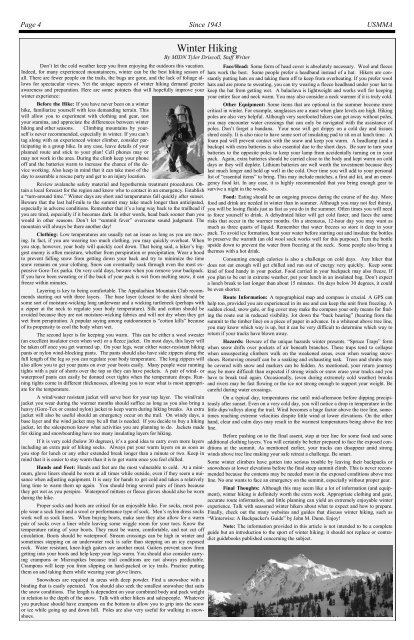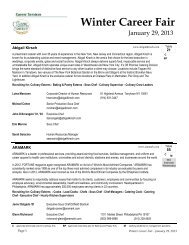Page 4 Since 1943 <strong>USMMA</strong>Don’t let <strong>the</strong> cold wea<strong>the</strong>r keep you from enjoying <strong>the</strong> outdoors this vacation.Indeed, for many experienced mountaineers, winter can be <strong>the</strong> best hiking season <strong>of</strong>all. <strong>The</strong>re are fewer people on <strong>the</strong> trails, <strong>the</strong> bugs are gone, <strong>and</strong> <strong>the</strong> lack <strong>of</strong> foliage allowsfor spectacular views. Yet <strong>the</strong> unique aspects <strong>of</strong> winter hiking dem<strong>and</strong> greaterawareness <strong>and</strong> preparation. Here are some pointers that will hopefully improve yourwinter experience:Before <strong>the</strong> Hike: If you have never been on a winterhike, familiarize yourself with less dem<strong>and</strong>ing terrain. Thiswill allow you to experiment with clothing <strong>and</strong> gear, testyour stamina, <strong>and</strong> appreciate <strong>the</strong> differences between winterhiking <strong>and</strong> o<strong>the</strong>r seasons. Climbing mountains by yourselfis never recommended, especially in winter. If you can’ttag along with an experienced winter climber, consider participatingin a group hike. In any case, leave details <strong>of</strong> yourplanned route <strong>and</strong> stick to your plan! Cell phones may ormay not work in <strong>the</strong> area. During <strong>the</strong> climb keep your phone<strong>of</strong>f <strong>and</strong> <strong>the</strong> batteries warm to increase <strong>the</strong> chance <strong>of</strong> <strong>the</strong> deviceworking. Also keep in mind that it can take most <strong>of</strong> <strong>the</strong>day to assemble a rescue party <strong>and</strong> get to an injury location.Review avalanche safety material <strong>and</strong> hypo<strong>the</strong>rmia treatment procedures. Obtaina local forecast for <strong>the</strong> region <strong>and</strong> know who to contact in an emergency. Establisha “turn-around time.” Winter days are short <strong>and</strong> temperatures fall quickly after sunset.Beware that <strong>the</strong> last half-mile to <strong>the</strong> summit may take much longer than anticipated,especially in adverse conditions. Remember that it’s a long way back to <strong>the</strong> trailhead ifyou are tired, especially if it becomes dark. In o<strong>the</strong>r words, head back sooner than youwould in o<strong>the</strong>r seasons. Don’t let “summit fever” overcome sound judgment. <strong>The</strong>mountain will always be <strong>the</strong>re ano<strong>the</strong>r day!Clothing: Low temperatures are usually not an issue as long as you are moving.In fact, if you are wearing too much clothing, you may quickly overheat. Whenyou stop, however, your body will quickly cool down. That being said, a hiker’s biggestenemy is <strong>of</strong>ten moisture, whe<strong>the</strong>r from perspiration or precipitation. Wear a hoodto prevent falling snow from getting down your back <strong>and</strong> try to minimize <strong>the</strong> timesnow remains on your clothing. Snow can eventually soak through even <strong>the</strong> most expensiveGore-Tex parka. On very cold days, beware when you remove your backpack.If you have been sweating or if <strong>the</strong> back <strong>of</strong> your pack is wet from melting snow, it canfreeze within minutes.Layering is key to being comfortable. <strong>The</strong> Appalachian Mountain Club recommendsstarting out with three layers. <strong>The</strong> base layer (closest to <strong>the</strong> skin) should besome sort <strong>of</strong> moisture-wicking long underwear <strong>and</strong> a wicking turtleneck (perhaps witha zipper at <strong>the</strong> neck to regulate your body temperature). Silk <strong>and</strong> cotton should beavoided because <strong>the</strong>y are not moisture-wicking fabrics <strong>and</strong> will not dry when <strong>the</strong>y getwet from perspiration. A popular saying among outdoorsmen is “cotton kills” because<strong>of</strong> its propensity to cool <strong>the</strong> body when wet.<strong>The</strong> second layer is for keeping you warm. This can be ei<strong>the</strong>r a wool sweater(an excellent insulator even when wet) or a fleece jacket. On most days, this layer willbe taken <strong>of</strong>f once you get warmed up. On your legs, wear ei<strong>the</strong>r water-resistant hikingpants or nylon wind-blocking pants. <strong>The</strong> pants should also have side zippers along <strong>the</strong>full length <strong>of</strong> <strong>the</strong> leg so you can regulate your body temperature. <strong>The</strong> long zippers willalso allow you to get your pants on over your boots easily. Many people wear runningtights with a pair <strong>of</strong> shorts over <strong>the</strong> top so <strong>the</strong>y can have pockets. A pair <strong>of</strong> wind- orwaterpro<strong>of</strong> pants can easily be donned over tights when <strong>the</strong> temperature drops. Runningtights come in different thicknesses, allowing you to wear what is most appropriatefor <strong>the</strong> temperature.A wind/water resistant jacket will serve best for your top layer. <strong>The</strong> wind/rainjacket you wear during <strong>the</strong> warmer months should suffice as long as you also bring aheavy (Gore-Tex or coated nylon) jacket to keep warm during hiking breaks. An extrajacket will also be useful should an emergency occur on <strong>the</strong> trail. On windy days, abase layer <strong>and</strong> <strong>the</strong> wind jacket may be all that is needed. If you decide to buy a hikingjacket, let <strong>the</strong> salesperson know what activities you are planning to do. Jackets madefor skiing <strong>and</strong> snowboarding have too many insulating layers for hiking.If it is very cold (below 30 degrees), it’s a good idea to carry even more layersincluding an extra pair <strong>of</strong> hiking socks. Always put your warm layers on as soon asyou stop for lunch or any o<strong>the</strong>r extended break longer than a minute or two. Keep inmind that it is easier to stay warm than it is to get warm once you feel chilled.H<strong>and</strong>s <strong>and</strong> Feet: H<strong>and</strong>s <strong>and</strong> feet are <strong>the</strong> most vulnerable to cold. At a minimum,glove liners should be worn at all times while outside, even if <strong>the</strong>y seem a nuisancewhen adjusting equipment. It is easy for h<strong>and</strong>s to get cold <strong>and</strong> takes a relativelylong time to warm <strong>the</strong>m up again. You should bring several pairs <strong>of</strong> liners because<strong>the</strong>y get wet as you perspire. Waterpro<strong>of</strong> mittens or fleece gloves should also be wornduring <strong>the</strong> hike.Proper socks <strong>and</strong> boots are critical for an enjoyable hike. For socks, most peoplewear a sock liner <strong>and</strong> a wool or performance type <strong>of</strong> sock. Men’s nylon dress sockswork well as sock liners. When buying boots, make sure <strong>the</strong>y also allow for a warmpair <strong>of</strong> socks over a liner while leaving some wiggle room for your toes. Know <strong>the</strong>temperature rating <strong>of</strong> your boots. <strong>The</strong>y must be warm, comfortable, <strong>and</strong> not cut <strong>of</strong>fcirculation. Boots should be waterpro<strong>of</strong>. Stream crossings can be high in winter <strong>and</strong>sometimes stepping on an underwater rock is safer than stepping on an icy exposedrock. Water resistant, knee-high gaiters are ano<strong>the</strong>r must. Gaiters prevent snow fromgetting into your boots <strong>and</strong> help keep your legs warm. You should also consider carryingcrampons or Microspikes because trail conditions are not always predictable.Crampons will keep you from slipping on hard-packed or icy trails. Practice putting<strong>the</strong>m on <strong>and</strong> taking <strong>the</strong>m while wearing your glove liners.Snowshoes are required in areas with deep powder. Find a snowshoe with abinding that is easily operated. You should also seek <strong>the</strong> smallest snowshoe that suits<strong>the</strong> snow conditions. <strong>The</strong> length is dependent on your combined body <strong>and</strong> pack weightin relation to <strong>the</strong> depth <strong>of</strong> <strong>the</strong> snow. Talk with o<strong>the</strong>r hikers <strong>and</strong> salespeople. Whateveryou purchase should have crampons on <strong>the</strong> bottom to allow you to grip into <strong>the</strong> snowor ice while going up <strong>and</strong> down hill. Poles are also very useful for walking in snowshoes.Winter HikingBy MIDN Tyler Driscoll, Staff WriterFace/Head: Some form <strong>of</strong> head cover is absolutely necessary. Wool <strong>and</strong> fleecehats work <strong>the</strong> best. Some people prefer a headb<strong>and</strong> instead <strong>of</strong> a hat. Hikers are constantlyputting hats on <strong>and</strong> taking <strong>the</strong>m <strong>of</strong>f to keep from overheating. If you prefer woolhats <strong>and</strong> are prone to sweating, you can try wearing a fleece headb<strong>and</strong> under your hat tokeep <strong>the</strong> hat from getting wet. A balaclava is lightweight <strong>and</strong> works well for keepingyour entire face <strong>and</strong> neck warm. You may also consider a neck warmer if it is truly cold.O<strong>the</strong>r Equipment: Some items that are optional in <strong>the</strong> summer become morecritical in winter. For example, sunglasses are a must when glare levels are high. Hikingpoles are also very helpful. Although very surefooted hikers can get away without poles,you may encounter water crossings that can only be navigated with <strong>the</strong> assistance <strong>of</strong>poles. Don’t forget a b<strong>and</strong>ana. Your nose will get drippy on a cold day <strong>and</strong> tissuesshred easily. It is also nice to have some sort <strong>of</strong> insulating pad to sit on at lunch time. Afoam pad will prevent contact with <strong>the</strong> snow <strong>and</strong> keep you warm. A headlamp (<strong>and</strong> abackup) with extra batteries is also essential due to <strong>the</strong> short days. Be sure to turn yourbatteries to <strong>the</strong> opposite poles to keep your lamp from accidentally turning on in yourpack. Again, extra batteries should be carried close to <strong>the</strong> body <strong>and</strong> kept warm on colddays or <strong>the</strong>y will deplete. Lithium batteries are well worth <strong>the</strong> investment because <strong>the</strong>ylast much longer <strong>and</strong> hold up well in <strong>the</strong> cold. Over time you will add to your personallist <strong>of</strong> “essential items” to bring. This may include matches, a first aid kit, <strong>and</strong> an emergencyfood kit. In any case, it is highly recommended that you bring enough gear tosurvive a night in <strong>the</strong> woods.Food: Eating should be an ongoing process during <strong>the</strong> course <strong>of</strong> <strong>the</strong> day. Morefood <strong>and</strong> drink are needed in winter than in summer. Although you may not feel thirsty,you will be losing fluids just as fast as you do in <strong>the</strong> summer. Often times you will needto force yourself to drink. A dehydrated hiker will get cold faster, <strong>and</strong> faces <strong>the</strong> samerisks that occur in <strong>the</strong> warmer months. On a strenuous, 12-hour day you may want asmuch as three quarts <strong>of</strong> liquid. Remember that water freezes so store it deep in yourpack. To avoid ice formation, heat your water before starting out <strong>and</strong> insulate <strong>the</strong> bottlesto preserve <strong>the</strong> warmth (an old wool sock works well for this purpose). Turn <strong>the</strong> bottleupside down to prevent <strong>the</strong> water from freezing at <strong>the</strong> neck. Some people also bring a<strong>the</strong>rmos with a hot drink.Consuming enough calories is also a challenge on cold days. Any hiker thatdoes not eat enough will get chilled <strong>and</strong> run out <strong>of</strong> energy very quickly. Keep somekind <strong>of</strong> food h<strong>and</strong>y in your pocket. Food carried in your backpack may also freeze. Ifyou plan to be out in extreme wea<strong>the</strong>r, put your lunch in an insulated bag. Don’t expecta lunch break to last longer than about 15 minutes. On days below 30 degrees, it couldbe even shorter.Route Information: A topographical map <strong>and</strong> compass is crucial. A GPS canhelp too, provided you are experienced in its use <strong>and</strong> can keep <strong>the</strong> unit from freezing. Asudden cloud, snow gale, or fog cover may make <strong>the</strong> compass your only means for finding<strong>the</strong> route out in reduced visibility. Jot down <strong>the</strong> “back bearing” (bearing from <strong>the</strong>summit to <strong>the</strong> timber line) on a piece <strong>of</strong> paper in advance. In a whiteout above tree line,you may know which way is up, but it can be very difficult to determine which way toreturn if your tracks have blown away.Hazards: Beware <strong>of</strong> <strong>the</strong> unique hazards winter presents. “Spruce Traps” formwhen snow drifts over pockets <strong>of</strong> air beneath branches. <strong>The</strong>se traps tend to collapsewhen unsuspecting climbers walk on <strong>the</strong> weakened areas, even when wearing snowshoes.Removing oneself can be a soaking <strong>and</strong> exhausting task. Trees <strong>and</strong> shrubs maybe covered with snow <strong>and</strong> markers can be hidden. As mentioned, your return journeymay be more difficult than expected if strong winds or snow erase your tracks <strong>and</strong> youhave to break trail again. Occasionally, (even during extremely cold wea<strong>the</strong>r) brooks<strong>and</strong> rivers may be fast flowing or <strong>the</strong> ice not strong enough to support your weight. Becareful during water crossings.On a typical day, temperatures rise until mid-afternoon before dipping precipitouslyafter sunset. Even on a very cold day, you will notice a drop in temperature in <strong>the</strong>little dips/valleys along <strong>the</strong> trail. Wind becomes a huge factor above <strong>the</strong> tree line, sometimesreaching extreme velocities despite little wind at lower elevations. On <strong>the</strong> o<strong>the</strong>rh<strong>and</strong>, clear <strong>and</strong> calm days may result in <strong>the</strong> warmest temperatures being above <strong>the</strong> treeline.Before pushing on to <strong>the</strong> final assent, stop at tree line for some food <strong>and</strong> someadditional clothing layers. You will certainly be better prepared to face <strong>the</strong> exposed conditionsat <strong>the</strong> summit. As mentioned earlier, your tracks can disappear amid strongwinds above tree line making your safe retreat a challenge. Be smart.Some winter climbers have gotten into serious trouble by leaving <strong>the</strong>ir backpacks orsnowshoes at lower elevations before <strong>the</strong> final steep summit climb. This is never recommendedbecause <strong>the</strong> contents may be needed most in <strong>the</strong> exposed conditions above treeline. No one wants to face an emergency on <strong>the</strong> summit, especially without proper gear.Final Thoughts: Although this may seem like a lot <strong>of</strong> information (<strong>and</strong> equipment),winter hiking is definitely worth <strong>the</strong> extra work. Appropriate clothing <strong>and</strong> gear,accurate route information, <strong>and</strong> little planning can yield an extremely enjoyable winterexperience. Talk with seasoned winter hikers about what to expect <strong>and</strong> how to prepare.Finally, check out <strong>the</strong> many websites <strong>and</strong> guides that discuss winter hiking, such as“Winterwise: A Backpacker's Guide” by John M. Dunn. Enjoy!Note: <strong>The</strong> information provided in this article is not intended to be a completeguide but an introduction to <strong>the</strong> sport <strong>of</strong> winter hiking; it should not replace or contradictguidebooks published concerning <strong>the</strong> subject.
Page 5 Since 1943 <strong>USMMA</strong>Don’t Taze Me, Bro!By MIDN Kate O’Connor, 2013“Power is <strong>of</strong> two kinds. One is obtained by <strong>the</strong> fear <strong>of</strong> punishment <strong>and</strong> <strong>the</strong> o<strong>the</strong>r by acts <strong>of</strong> love. Power based on love is a thous<strong>and</strong> times more effective <strong>and</strong> permanent than <strong>the</strong>one derived from fear <strong>of</strong> punishment.” –Moh<strong>and</strong>as G<strong>and</strong>hi<strong>The</strong> word “punishment” is defined by Merriam-Webster’s dictionary as “apenalty inflicted on an <strong>of</strong>fender through judicial procedure.” <strong>The</strong> American culture isone which innately believes in punishment. We believe <strong>the</strong> act <strong>of</strong> punishment to be onewhich will elicit a positive response from <strong>the</strong> culprit once it has been administered.While growing up, through time-outs, groundings <strong>and</strong> even spankings, ourparents punished us when we misbehaved. In <strong>the</strong> 1700s, when slavery was commonthroughout <strong>the</strong> United States, slave owners beat <strong>the</strong>ir slaves when <strong>the</strong>y failed to adhereto <strong>the</strong>ir masters’ rules. When training a dog, a common school <strong>of</strong> thought is to follow apunishment-based system. When <strong>the</strong> dog performs poorly, or does something its ownerfinds unsatisfactory, <strong>the</strong> animal is corrected by a sharp slap, leash jerk or scolding. In<strong>the</strong> United States, when a serious crime is committed, <strong>the</strong> fastest <strong>and</strong> easiest solution isto simply put <strong>the</strong> <strong>of</strong>fender in prison.<strong>The</strong> thing all <strong>the</strong> above examples have in common is that <strong>the</strong> negative cause(<strong>the</strong> crime) ultimately leads to a negative effect (<strong>the</strong> punishment). In all <strong>of</strong> <strong>the</strong> scenarios,ei<strong>the</strong>r an undesirable stimulus is provided or a desirable stimulus is removed. <strong>The</strong>reare, however, several problems associated with this form <strong>of</strong> punishment as a means <strong>of</strong>discipline. Evidence has demonstrated that it tends to lead to alienation <strong>of</strong> those punished,inhibits desirable learning, in that it does not teach right from wrong, <strong>and</strong> caneven lead to an increase in aggression amongst <strong>the</strong> <strong>of</strong>fending party. While this type <strong>of</strong>negative punishment may lead to immediate compliance, it fails to correct in <strong>the</strong> longterm. In addition, while <strong>the</strong> <strong>of</strong>fender may be afraid to disobey while <strong>the</strong> disciplinarianis present, when absent, <strong>the</strong>y will more than likely go back to <strong>the</strong>ir original ways.On <strong>the</strong> o<strong>the</strong>r side <strong>of</strong> <strong>the</strong> spectrum is what is commonly referred to as operantconditioning or positive reinforcement. <strong>The</strong> basis <strong>of</strong> this reinforcement system is tocreate a response to an action that a person will enjoy or to remove a stimulus a persondoes not like. For example, to train a dog to fetch a ball, when <strong>the</strong> dog successfullychases <strong>and</strong> picks up <strong>the</strong> ball, <strong>the</strong> dog receives praise. If <strong>the</strong> dog fails, <strong>the</strong> praise is withheld.Eventually, <strong>the</strong> dog associates his behavior with <strong>the</strong> reward <strong>and</strong> will continue toretrieve <strong>the</strong> ball. Like <strong>the</strong> dog, people are driven by success. We become more likely torepeat a behavior which elicits a positive outcome than a negative one.While both punishment-based systems <strong>and</strong> positive reinforcement systemshave <strong>the</strong>ir distinct advantages <strong>and</strong> disadvantages, generally, people will not learnthrough <strong>the</strong> application <strong>of</strong> just one. <strong>The</strong> best learning is done through a combination <strong>of</strong><strong>the</strong> two systems <strong>and</strong> involves numerous trade-<strong>of</strong>fs in <strong>the</strong> process. Not all people arecapable <strong>of</strong> learning <strong>the</strong> same way or even at <strong>the</strong> same rate, <strong>and</strong> that holds true within<strong>the</strong> <strong>Regiment</strong>al training system here at <strong>the</strong> Merchant Marine Academy.Over <strong>the</strong> past three <strong>and</strong> a half years here, I have come to find that <strong>the</strong> disciplinarysystem is severely skewed toward <strong>the</strong> methodology <strong>of</strong> simply punishing <strong>the</strong> midshipmen.Within <strong>the</strong> system to “stick” midshipmen, <strong>the</strong>re are well over 100 items forwhich a person can be placed on report. With so many “crimes” that we can be punishedfor, it seems that demerits, marching tours <strong>and</strong> restriction sentences are issuedleft <strong>and</strong> right, night <strong>and</strong> day, backwards <strong>and</strong> forwards. From <strong>the</strong> moment I open mydoor at 0616 (oops, I mean 0615…I could get in trouble for that extra 60 seconds <strong>of</strong>privacy) I can be stuck for just about anything- room in gross disorder, unkempt personalappearance, “skylarking” across <strong>the</strong> hall to my company mates…<strong>and</strong> <strong>the</strong> list goeson. Well, my million dollar question is this: Where is <strong>the</strong> system which can track amidshipman’s positive behavior?Most things in this world have an opposite or counterpart—for every up <strong>the</strong>re isa down, for every win <strong>the</strong>re is a loss, <strong>and</strong> for every back <strong>the</strong>re is a front. Why <strong>the</strong>n hasKings Point gone so far astray from this governing law <strong>and</strong> failed to pair <strong>the</strong> demeritsystem with some sort <strong>of</strong> similar, structured, merit-based system? A disciplinary systemis one which is fundamental to <strong>the</strong> smooth operation <strong>of</strong> any military academy,school or organization <strong>of</strong> structure. If it st<strong>and</strong>s to be so fundamental, why has <strong>the</strong> disciplinarysystem here at <strong>the</strong> Academy been formed into one that is so single-minded? Asnot everyone is motivated by <strong>the</strong> same stimuli, it st<strong>and</strong>s to reason that <strong>the</strong> same form <strong>of</strong>punishment will not be effective for every single midshipman.Now, I am not trying to say that every time I put my hair into a perfect bun or amale midshipman shaves in <strong>the</strong> morning, we should be rewarded. Certain things shouldjust be expected. However, something needs to be implemented to provide a little morepositive reinforcement to <strong>the</strong> student body. I think that if this were to occur, not onlycould we implement a positivity-based disciplinary system in addition to <strong>the</strong> one wealready have, but we would also begin to see <strong>the</strong> overall morale <strong>of</strong> <strong>the</strong> student bodyimprove.1 Henry, Stuart, Ph.D. “On <strong>the</strong> Effectiveness <strong>of</strong> Prison as Punishment.” Wayne State University. http://www.is.wayne.edu/stuar<strong>the</strong>nry/Effectiveness_<strong>of</strong>_Punishment.htm2 American Psychological <strong>Association</strong>. “Is Corporal Punishment an Effective Means <strong>of</strong> Discipline?” http://www.apa.org/news/press/releases/2002/06/spanking.aspxRoman Catholic LeaderAnnounces ResignationBy MIDN Kevin F. McHale, Staff WriterPope Benedict XVI <strong>of</strong>ficially announced his resignationon 11 February 2013 as leader <strong>of</strong> <strong>the</strong> Roman CatholicChurch, a decision that elicited surprise from many around <strong>the</strong>world. <strong>The</strong> resignation certainly came as a shock to <strong>the</strong> morethan one billion Roman Catholics in <strong>the</strong> world. <strong>The</strong> leader <strong>of</strong><strong>the</strong> world’s largest single church cited his decision as beingcaused by a “lack <strong>of</strong> strength <strong>of</strong> mind <strong>and</strong> body.”<strong>The</strong> resignation <strong>of</strong> a Pope, while not unheard <strong>of</strong> in <strong>the</strong>history <strong>of</strong> <strong>the</strong> Church, is extremely rare. <strong>The</strong> last Pope to resignwas Gregory XII in 1415! However, even Gregory didn’tvolunteer to leave. <strong>The</strong> last voluntary abdication was PopeCelestine V in 1294. Within recent centuries, <strong>the</strong> papacy hasusually ended with <strong>the</strong> death <strong>of</strong> <strong>the</strong> sitting Pope, leading to <strong>the</strong>conclave <strong>of</strong> <strong>the</strong> Church’s hierarchy to decide who is <strong>the</strong> nextPope.<strong>The</strong> announcement left many wondering what promptedsuch a momentous decision. <strong>The</strong> Thursday edition <strong>of</strong> Italiannewspaper, La Stampa, reporting on information that had arisenafter Monday’s decision, shed some light on potential medicalissues that may have contributed to his decision. Apparently,<strong>the</strong> Pope suffered a head injury <strong>and</strong> bleeding while in Mexicoin March 2012. According to CBS News, however, <strong>the</strong>Vatican has <strong>of</strong>ficially denied that this incident played a role in<strong>the</strong> Pope’s resignation.Whatever <strong>the</strong> causes <strong>of</strong> <strong>the</strong> resignation, one thing iscertain: <strong>the</strong> transfer <strong>of</strong> power in <strong>the</strong> Catholic Church will elicitmuch media attention <strong>and</strong> global interest. <strong>The</strong> man elected as<strong>the</strong> next Pope will speak volumes about <strong>the</strong> direction that <strong>the</strong>Church is heading. <strong>The</strong> election <strong>of</strong> Pope Benedict XVI was aconfirmation that <strong>the</strong> Church would continue on a <strong>the</strong>ologicallyconservative path set by his predecessor Pope John Paul II.<strong>The</strong> potential c<strong>and</strong>idates for <strong>the</strong> Papacy include cardinals fromAfrica, Europe, Latin America <strong>and</strong> potentially <strong>the</strong> UnitedStates. Catholics around <strong>the</strong> world are hoping <strong>and</strong> praying fora Pope who will streng<strong>the</strong>n <strong>the</strong> faith, be a spiritual guide <strong>and</strong>be able to connect with <strong>the</strong> average believer. Once more <strong>the</strong>world will be able to witness a two millennia old ceremony forelecting <strong>the</strong> leadership <strong>of</strong> <strong>the</strong> Church.1 http://www.cbsnews.com/8301-202_162-57569366/retiringpope-benedict-xvi-will-be-hidden-to-<strong>the</strong>-world/2 http://en.wikipedia.org/wiki/Pope_benedict_XVIConversations withA Cal Maritime DeckieBy MIDN Dustin Downing, Staff WriterOur travels in life <strong>and</strong> at this Academy bring us intouch with people <strong>of</strong> all kinds. My journey had <strong>the</strong> fortune<strong>of</strong> crossing paths with a great man from Cal Maritime.I highly respect him <strong>and</strong> what he has to say, <strong>and</strong> hadsome questions for him about <strong>the</strong> differences in culturebetween his Academy <strong>and</strong> ours. A few <strong>of</strong> <strong>the</strong>se questionsare brought by yours truly, <strong>and</strong> o<strong>the</strong>rs are submitted bycurious section-mates. <strong>The</strong> following is a result <strong>of</strong> thatdiscussion:How many formations do you have per week<strong>and</strong> what goes on <strong>the</strong>re?We have to be in formation by 0720 on Monday,Wednesday, <strong>and</strong> Friday. Once every week or two, we getinspected, but <strong>the</strong>y’re quite lax—a friend <strong>of</strong> mine hasn’tworn a nametag for a few weeks. Nothing in <strong>the</strong> afternoonsor evenings though, <strong>and</strong> if you don’t have classbefore 1100, you don’t have to go to formation.What is your student body demographic?<strong>The</strong> Cal state schools demolished <strong>the</strong> Affirmative Actionsystem, so most <strong>of</strong> our classes are ra<strong>the</strong>r homogeneous.Our business major seems to attract most <strong>of</strong> thosebrought in on Basketball scholarships though. Though<strong>the</strong>re is little diversity, those that are here are mostlybrought in by race-specific scholarships. However, thisschool does attract many from <strong>the</strong> GI bill that are unableto attend KP due to <strong>the</strong> age requirement. <strong>The</strong>se veteransadd experience <strong>and</strong> a check to <strong>the</strong> <strong>of</strong>ficership we aretaught here. <strong>The</strong>y are great leaders from what I have seen<strong>and</strong> add tremendously to <strong>the</strong> demographic <strong>of</strong> experience.What is <strong>the</strong> drinking policy <strong>and</strong> is pot legal oncampus?Absolutely no drugs are allowed on campus <strong>and</strong> no alcoholwhatsoever unless it’s a faculty-sanctioned event. Weall get drug tested, but it’s not very frequent. <strong>The</strong>re’s actuallyquite a strict alcohol policy, but <strong>the</strong>re are manyo<strong>the</strong>r Cal State schools which allow it.What is <strong>the</strong> role <strong>of</strong> <strong>the</strong> Comm<strong>and</strong>ant Staff?<strong>The</strong>re is quite a bit <strong>of</strong> talk about changing Cal to be ‘anew Cal Maritime’ <strong>and</strong> having many in <strong>the</strong> Comm<strong>and</strong>ant’sdepartment put <strong>the</strong>ir ‘mark’ on <strong>the</strong> school. Thismanifests itself in little ways, but <strong>the</strong>re’s a reason <strong>the</strong>sethings have been done this way. For instance: <strong>the</strong>department has changed <strong>the</strong> way we face in formationso now I’m looking into <strong>the</strong> blue sky instead<strong>of</strong> down <strong>the</strong> line at my squad, <strong>and</strong> I don’t know who<strong>the</strong>y are now. I told <strong>the</strong> Comm<strong>and</strong>ant himself beforethis change <strong>and</strong> after that this would be a problem,reaching nothing but a deaf ear. But hey, we lookgood in formation.What did you see in Vallejo during yourfirst time on campus?A week before school started: <strong>the</strong> clerk down <strong>the</strong>street was shot in <strong>the</strong> face, a hooker <strong>of</strong>fered to take atopless picture with me for a dollar, <strong>and</strong> a lady hadher purse stolen in broad daylight downtown. Thistown is nothing but class.Do you see anything at KP that you wantat Cal Maritime?A badass Gangnam Style <strong>and</strong> your yachts.Is <strong>the</strong>re anything you see at KP thatmakes you happy to be at Cal Maritime?Honestly, I love <strong>the</strong> fact that we aren’t in <strong>the</strong> military<strong>and</strong> <strong>the</strong> administration does a pretty good job <strong>of</strong>not pretending we are. We don’t march with rifles orspit shine our shoes because those skills don’t applyto being a merchant mariner—we put on our jankysteel-toed boots <strong>and</strong> go to work. <strong>The</strong>re is a real‘back to basics’ attitude here about <strong>the</strong> pr<strong>of</strong>essionalconduct at sea <strong>and</strong> letting <strong>the</strong> little stuff go by <strong>the</strong>wayside. I can’t say I remember ironing my uniformlately <strong>and</strong>, aside from that, I’ve made <strong>the</strong> Dean’s listfor most <strong>of</strong> my time here <strong>and</strong> that gets recognized.I emerged from <strong>the</strong> conversation a little wiser<strong>and</strong> a little jealous, but today I still sit here <strong>and</strong>not in my home state. As <strong>of</strong> this writing, <strong>the</strong> SeniorClass has 124 days until graduation, <strong>and</strong> <strong>the</strong> sacrificesI have experienced here served two purposes: tobuild tighter bonds among mids, <strong>and</strong> to justify ourexpense to <strong>the</strong> taxpayer. Many <strong>of</strong> <strong>the</strong> hoops we jumpthrough do not make a better sailor (merchant orNavy), but <strong>the</strong>y serve to symbolize that we are hereby dedication to <strong>the</strong> education. Alas, my good friendwill have had a good time, but someone has to pay<strong>the</strong> 80-100k his education dem<strong>and</strong>s. Personally, Ichoose <strong>the</strong> difficulties inherent in Kings Point asopposed to debt or burden on parents. To some, <strong>the</strong>grass may be greener on <strong>the</strong> o<strong>the</strong>r side, but betterfriends are made in <strong>the</strong> s<strong>and</strong> lot.















